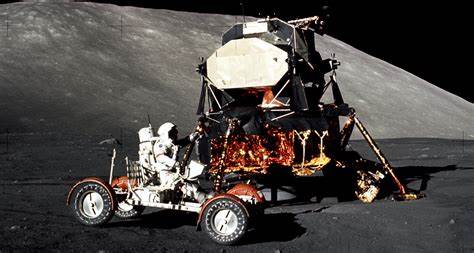Apollo 17
Fifty years ago, in December 1972, mankind left the moon for the last time.
Apollo 17 landed the last men on the Moon – so far.
It saw the end of the Apollo project, a venture that involved almost half a million people.
NASA had triumphed by placing twelve men on the Moon and returning them safely to the Earth.
The 50th anniversary gives us the opportunity to look back at the final Apollo mission.
Mission quick facts
- Landing area was Taurus-Littrow.
- Objective: Search for rocks older and younger than on previous missions.
- Command module: America
- Lunar module: Challenger
- Mission duration: 12 days, 14 hours
- Time on Moon’s surface: 3 days, 3 hours
The astronauts
Mission commander: Gene Cernan
Gene Cernan was born in Chicago in 1934.
He was awarded an MSc in aeronautical engineering in 1956.
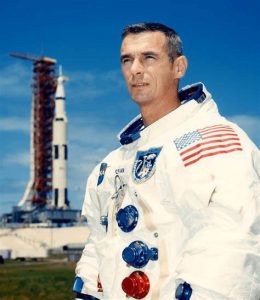
Gene Cernan. Photo: NASA
Cernan became an astronaut in 1963 and flew on Gemini 9.
In 1969 he was the lunar module pilot on Apollo 10, which descended to within 9 miles of the lunar surface.
Command Module pilot: Ronald Evans
Evans was born in Kansas in 1933.
Like Gene Cernan, he received an MSc in aeronautical engineering, in 1964.
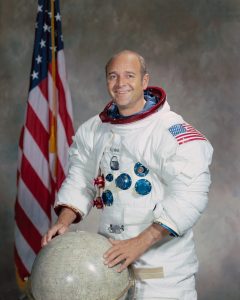
Ronald Evans. Photo: NASA
He was a combat flight instructor when he joined NASA in 1966.
Ronald was back-up astronaut for Apollos 7, 11 and 14 before his first spaceflight with Apollo17.
Lunar Module Pilot: Harrison Schmitt
Schmitt was born in Santa Rita, Mew Mexico in 1933.
He gained a PhD in Geology from Harvard in 1964.
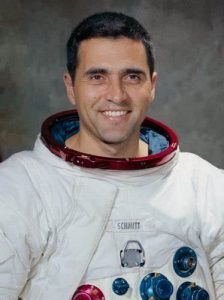
Harrison Schmitt. Photo: NASA
Schmitt was one of three astronaut-geologists recruited by NASA in 1965.
He was to have flown on Apollo 18 but when that mission was cancelled, he replaced Joe Engle on Apollo 17.
Lift-off and Landing
After a delay of a couple of hours, Apollo 17 lifted off at 12.33am on 7th December,1972.
It was the only night-time launch of the Apollo missions.
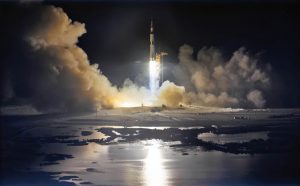
Apollo 17 launch. Photo: NASA
The spacecraft entered lunar orbit some 83 hours after launch.
The chosen landing area at Taurus-Littrow was a small 1km circle.
On touching down, Challenger was only 200 metres away from its planned point.
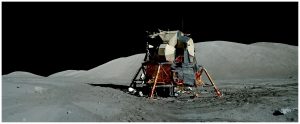
Apollo 17 lunar module on Moon. Photo: NASA
After a four hour rest, the astronauts prepared to step on to the Lunar surface.
First was Gene Cernan, who dedicated his first step to ‘all who made it possible’.
Activities on the Moon
Cernan and Schmitt spent 75 hours on the Moon.
They made three excursions, or EVAs, Extra-Vehicular Activities.
After deploying the Lunar Rover they drove to various sites and collected rock samples.
Cernan drove the rover whilst geologist Schmitt acted as navigator.
The first EVA lasted 7 hours, after which they returned to the lander.
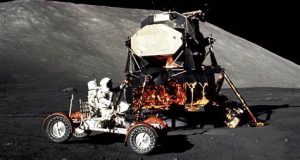
Apollo 17 lunar rover. Photo: NASA
After a 17 hour rest, the astronauts first job was to repair a broken fender on the rover.
Cernan had accidentally broken it with his hammer at the start of the mission.
Whilst driving, the astronauts had been sprayed with moon dust.
The fix was made with card maps and duct tape.
During the EVA, Schmitt overbalanced and fell.
Mission control told him that Houston Ballet were now interested in his services.
A nearby crater was named Ballet Crater!
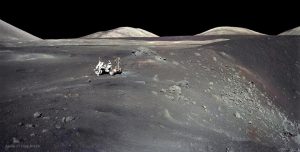
Apollo 17 rover at Shorty Crater. Photo: NASA
At Shorty Crater they found orange soil. It proved to be glass beads from an ancient fire fountain.
Their excursion of 7 hours 37 minutes was the longest ever Lunar EVA.
The distance travelled from Challenger was 7.6 km, 4.7 miles, also a record.
The third EVA took the astronauts to the base of nearby hills.
They collected more rock samples and named a huge boulder ‘Tracy’s Rock‘ after Cernan’s daughter.
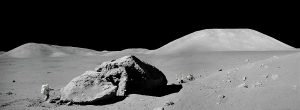
Tracy’s Rock. Photo NASA
After 7 hours and 15 minutes, they returned to the lander.
Schmitt climbed in and as Cernan followed he said ‘we leave as we came and,
God willing, as we shall return, with peace and hope for all mankind’.
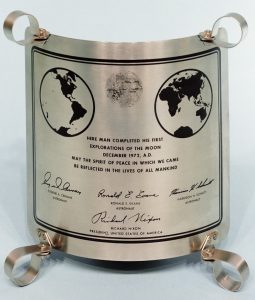
Replica of Apollo 17 plaque. NASA
The plaque on the base of the lander left on the Moon echoed this thought.
‘May the spirit of peace in which we came be reflected in the lives of all mankind’.
Return to Earth
The ascent stage of the lunar module lifted off around 6pm on December 14th.
Two hours later it docked with the Command module and Ronald Evans.
On the return to earth, Gene Cernan took one of the most famous images of the Apollo programme.
He photographed the full Earth, the ‘blue marble’.
It was the last time any human had seen our planet in its entirety.
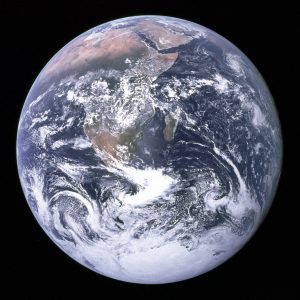
The ‘Blue Marble’. Photo: NASA
Before landing back on Earth, Evans made the final EVA of the Apollo programme.
He went outside to the service module to retrieve some film cassettes.
The Command module splashed down in the Pacific at 2.25pm EST on December 19th.
Apollo 17 concluded the Apollo programme with success.
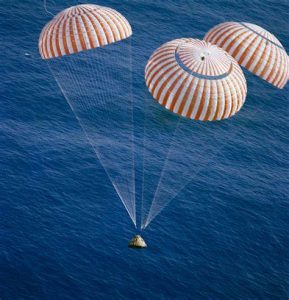
Apollo 17 splashdown. Photo: NASA
The astronauts had set new duration records and set up experiments on the lunar surface.
They brought back 115kg of lunar rock samples.
What happened to the astronauts?
Ronald Evans retired from NASA in 1977 to work for a private company.
He died in April,1990.
Harrison Schmitt left NASA in 1975 and became a US senator representing New Mexico.
He lives in Silver City, New Mexico.
Gene Cernan, last man to walk on the Moon, retired from NASA in 1976.
He died in January 2017, aged 82.
Apollo 17 in Wonderdome.
Many of our planetarium shows include a full dome video sequence ‘Back to the Moon’.
It features Apollo 17 leaving the Moon and acts as a prelude for the Artemis mission to come.
The author: Dennis Ashton is a Fellow of the Royal Astronomical Society and a Wonderdome presenter.
Would you like to hear more Astronomy news?
Do you want to to find out about our upcoming public events?
Follow WonderDome Portable Planetarium on Twitter and Facebook or go to our web site wonderdome.co.uk

